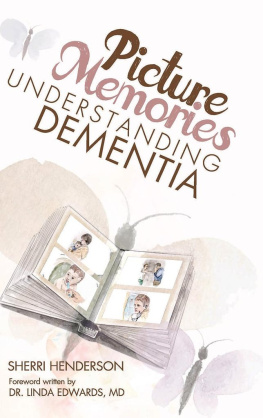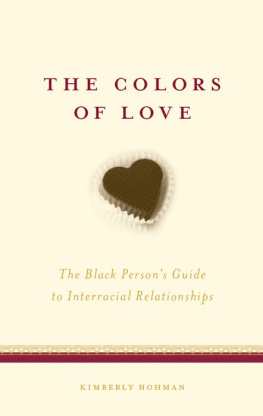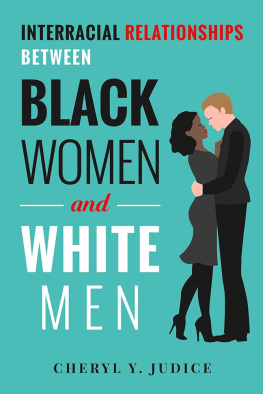First published 2006 by Transaction Publishers
Published 2017 by Routledge
2 Park Square, Milton Park, Abingdon, Oxon OX14 4RN
711 Third Avenue, New York, NY 10017, USA
Routledge is an imprint of the Taylor & Francis Group, an informa business
Copyright 2006 by Taylor & Francis.
All rights reserved. No part of this book may be reprinted or reproduced or utilised in any form or by any electronic, mechanical, or other means, now known or hereafter invented, including photocopying and recording, or in any information storage or retrieval system, without permission in writing from the publishers.
Notice:
Product or corporate names may be trademarks or registered trademarks, and are used only for identification and explanation without intent to infringe.
Library of Congress Catalog Number: 2005054948
Library of Congress Cataloging-in-Publication Data
Craig-Henderson, Kellina M.
Black men in interracial relationships : whats love got to do with it? /Kellina M. Craig-Henderson.
p. cm.
Includes bibliographical references.
ISBN 0-7658-0309-7 (alk. paper)
1. Interracia ldatingUnited States. 2. Interracial marriageUnited States. 3. African American menAttitudes. 4. Man-woman relationships. I. Title.
HQ801.8.C73 2005
306.84'608996073dc22
2005054948
ISBN 13: 978-0-7658-0309-2 (hbk)
To African American women who have wondered what love has to do with it.
1
Why Look at Black Men in Interracial Relationships?
Not long ago I lived in a small, Midwestern town about 135 miles south of Chicago. At that time, I was on the faculty of a large research-oriented university where Black professors were rare. In my primary department, which regularly boasted a faculty of 70 to 75 Ph.D.s, I was one of three people of color and the only African American. Indeed, there were so few Black professors present at that university that when more than one person was present the topic of conversation invariably turned to our dismal representation on the faculty and our less than optimal lives away from work in that very small, White, Midwestern town. Aside from our academic appointments, there was little in the way of cultural or social activities. Many of us relied heavily on the functions sponsored by the Black studies unit on campus to meet and greet others with similar interests, histories, and experiences. On one of these occasions, I befriended a petite, attractive woman, Carla, who had recently joined the faculty of the law school at the university.
We became good friends, and periodically joked about the fact that we were both single and had pretty limited social lives. At those times, we consoled ourselves by reminding each other that we had good jobs and were employed at a top-ranking institution. For us, as well as the many other academics employed at prestigious universities in the United States, there was a bitter irony to our relative successes.
Carla and I got together frequently for conversation and laughs. During one of these times, we discussed who among the men on the faculty was Black, single, and straight. There werent many, and by the time we identified each of them, we realized we both knew about one particular man who had recently obtained an appointment as an associate professor in the engineering school. I knew of him only because I had seen his photograph in a campus publication of new faculty. It was a good picture, and Paul had an engaging and warm smile. His complexion was dark chestnut brown, and his attractive smile showed off a beautiful set of teeth. In all respects, his photograph was flattering. I remembered it well and immediately hunted out the issue of the faculty publication in which it appeared for Carla.
As it turned out, although she had never seen him before looking at the picture I showed her, Carlas knowledge of Paul went well beyond awareness of his good looks and marital status. Apparently, one of her female colleagues, Susan, fancied herself a matchmaker. Carla was friendly with Susan, and when Susan made repeated overtures to introduce her to Paul, a good-looking professor shed met recently at the gym, she always declined. On more than one occasion, Susan encouraged her to consent to the introduction. Eventually Carla gave in, and although she had never seen Paul, she agreed to allow Susan to hook her up. After all, she reasoned, Susan swore he was intelligent, attractive, single, heterosexual, and socially skilled. How could she pass up an opportunity to meet this guy? Even if it wasnt a love connection, it would at least be a chance to make a new friend. After giving Susan permission to make the introduction, she anxiously awaited word from her.
About a week later, Susan came to Carla with some rather sobering news. She explained she had, indeed, caught up with Paul at the gym and told him of her desire to introduce him to her friend and colleague. She said she had described her as a single, youthful, attractive Black woman who was also new to the area. Susan told Carla not only had Paul declined the chance to meet her, but he had asked out Susan instead! Susan was White. According to Susan, when she expressed surprise at his response, Paul explained he had nothing in common with Black women, and he was not particularly interested in meeting, much less dating, any of them. Susan was already involved with someone else and did not take him up on his invitation. Carla never questioned Susans motives, and as for Susan, she never brought up the subject of matchmaking again.
After getting over my own disappointment with Paul and his remark, I thought about the implications of what he had said and the extent to which it may or may not have been echoed by other similarly educated and employed Black men. I really did not understand what he meant about not having anything in common with Black women, and I plied Carla with a host of questions about her own reactions to what he had said. Together, we began to consider the implications of his remark in earnest. Here was a man of African descent who was clearly identifiable as such by anybodys classification system. That is to say, he had a dark complexion and features characteristic of people whose ancestry can be visibly traced to Africa. Yet, he consciously and explicitly chose not to have anything to do with women who, no doubt, looked a lot like any one of the women in his own family, or for that matter, his own birth mother. What could account for this? Since that time, I have struggled to come up with a reasonable explanation.












